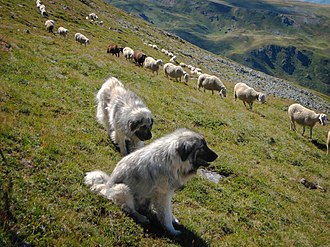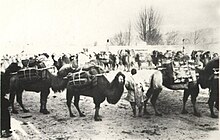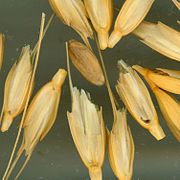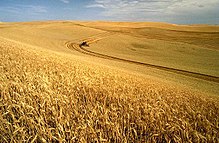Domestication


Domestication is a multi-generational mutualistic relationship between humans and other organisms, in which humans took over control and care to obtain a steady supply of resources including food. The process was gradual and geographically diffuse, based on trial and error.
The first
, respectively.The domestication of plants began around 13,000–11,000 years ago with
Domestication affected genes for behavior in animals, making them less aggressive. In plants, domestication affected genes for morphology, such as increasing seed size and stopping the shattering of seed-heads such as in wheat. Such changes both make domesticated organisms easier to handle, and reduce their ability to survive in the wild.
Definitions
Domestication (not to be confused with the
Domestication syndrome is the suite of phenotypic traits which arose during the initial domestication process, and which distinguish crops from their wild ancestors.[10][11] It can also mean a set of differences now observed in domesticated animals, not necessarily reflecting the initial domestication process. The changes include increased docility and tameness, coat coloration, reductions in tooth size, craniofacial morphology, ear and tail form (e.g., floppy ears), estrus cycles, levels of adrenocorticotropic hormone and neurotransmitters, prolongations in juvenile behavior, and reductions in brain size and of particular brain regions.[12]
Cause and timing
The
| Event | Centre of origin | Purpose | Date/years ago |
|---|---|---|---|
| Foraging for wild grains | Asia | Food | > 23,000[15] |
| Dog | Eurasia | Commensal | > 15,000[1] |
| Rice | China | Food | 13,500–8,200[2] |
| Wheat, Barley | Near East | Food | 13,000–11,000[15] |
| Flax | Near East | Textiles | 13,000–11,000[16] |
Cow |
Near East, South Asia | Food | 11,000–10,000[1] |
| Chicken | East Asia | Cockfighting |
7,000[17] |
| Horse | Central Asia | Draft, riding | 5,500[1] |
The appearance of the
In the
Animals
Desirable traits
The domestication of animals is the relationship between animals and humans who have influence on their care and reproduction.[7] In his 1868 book The Variation of Animals and Plants Under Domestication, Charles Darwin recognized the small number of traits that made domestic species different from their wild ancestors. He was also the first to recognize the difference between conscious selective breeding in which humans directly select for desirable traits, and unconscious selection in which traits evolve as a by-product of natural selection or from selection on other traits.[26][27][28]
There is a difference between domestic and wild populations; some of these differences constitute the domestication syndrome, traits presumed essential in the early stages of domestication, while others represent later improvement traits.[10][29][30] Domesticated animals tend to be smaller and less aggressive than their wild counterparts; other common traits are floppy ears, a smaller brain, and a shorter muzzle.[25] Domestication traits are generally fixed within all domesticates, and were selected during the initial episode of domestication of that animal or plant, whereas improvement traits are present only in a proportion of domesticates, though they may be fixed in individual breeds or regional populations.[29][30][31]
Certain animal species, and certain individuals within those species, make better candidates for domestication because of their behavioral characteristics:[32][33][34][35]
- The size and organization of their social structure[32]
- The availability and the degree of selectivity in their choice of mates[32]
- The ease and speed with which the parents bond with their young, and the maturity and mobility of the young at birth[32]
- The degree of flexibility in diet and habitat tolerance[32]
- Responses to humans and new environments, including reduced flight response and reactivity to external stimuli.[32]
Mammals

The beginnings of animal domestication involved a protracted coevolutionary process with multiple stages along different pathways. There are three proposed major pathways that most animal domesticates followed into domestication:[32][30][36]
- pigs)[32]
- prey animals sought for food (e.g.,
- animals targeted for draft and riding (e.g., horse, donkey, camel).[32]
Humans did not intend to domesticate animals from either the commensal or prey pathways, or at least they did not envision a domesticated animal would result from it. In both of those cases, humans became entangled with these species as the relationship between them intensified, and humans' role in their survival and reproduction led gradually to formalised animal husbandry.[30] Although the directed pathway for draft and riding animals proceeded from capture to taming, the other two pathways are not as goal-oriented, and archaeological records suggest that they took place over much longer time frames.[37]
Unlike other domestic species selected primarily for production-related traits, dogs were initially selected for their behaviors.[9][38] The dog was domesticated long before other animals,[39][40] becoming established across Eurasia before the end of the Late Pleistocene era, well before agriculture.[39]
The archaeological and genetic data suggest that long-term bidirectional gene flow between wild and domestic stocks – such as in donkeys, horses, New and Old World camelids, goats, sheep, and pigs – was common. [30][36] Human selection for domestic traits likely counteracted the homogenizing effect of gene flow from wild boars into pigs, and created domestication islands in the genome. The same process may apply to other domesticated animals. [41][42]
The 2023
Birds
Domesticated birds principally mean
Invertebrates
Two
Several other invertebrates have been domesticated, both terrestrial and aquatic, including some such as
-
silkworms for spinning of the silk
-
The lac bug Kerria lacca has been kept for shellac resin.
Plants
Humans
Continued domestication was gradual and geographically diffuse – happening in many small steps and spread over a wide area – on the evidence of both archaeology and genetics.[62] It was a process of intermittent trial and error, and often resulted in diverging traits and characteristics.[63]
Whereas domestication of animals impacted most on the genes that controlled behavior, that of plants impacted most on the genes that controlled morphology (seed size, plant architecture, dispersal mechanisms) and physiology (timing of germination or ripening),
-
Farmers with wheat and cattle – Ancient Egyptian art 3,400 years ago
-
Wild wheat ears shatter when ripe, but domesticated wheat has to be threshed and winnowed (as shown) to release and separate the grain. Photograph by Harold Weston, Iran, 1920s
Differences from wild plants

Domesticated plants differ from their wild relatives in many ways, including
- lack of shattering such as of cereal ears (ripe heads),[15] loss of fruit abscission[65]
- less efficient pollinating organs, making human intervention a requirement), larger seeds with lower success in the wild,[15] or even sterility (e.g. seedless fruits) and therefore only vegetative reproduction[66][67]
- better palatability (e.g. higher sugar content, reduced bitterness), better smell, and lower toxicity[68][69]
- edible part larger, e.g. cereal grains[70] or fruits[65]
- edible part more easily separated from non-edible part[70]
- increased number of fruits or grains[65]
- altered color, taste, and texture[65]
- daylength independence[65]
- determinate growth[65]
- reduced or no vernalization[65]
- less seed dormancy.[65]
Changes to plant genome

During domestication, crop species undergo intense artificial selection that alters their genomes, establishing core traits that define them as domesticated, such as increased grain size.
In
In wheat, domestication involved repeated hybridization and polyploidy. These steps are large and essentially instantaneous changes to the genome and the epigenome, enabling a rapid evolutionary response to artificial selection. Polyploidy increases the number of chromosomes, bringing new combinations of genes and alleles, which in turn enable further changes such as by chromosomal crossover.[72]
Impact on plant microbiome
The microbiome, the collection of microorganisms inhabiting the surface and internal tissue of plants, is affected by domestication. This includes changes in microbial species composition[78][79][80] and diversity.[81][80] Plant lineage, including speciation, domestication, and breeding, have shaped plant endophytes (phylosymbiosis) in similar patterns as plant genes.[80][82][83][84]
Fungi

Several species of
Effects
On domestic animals
Selection of animals for visible traits may have undesired consequences for the genetics of domestic animals.
On society
Scholars have expressed widely differing viewpoints on domestication's effects on society.
On diversity

Domesticated ecosystems provide food, reduce predator and natural dangers, and promote commerce, but their creation has resulted in habitat alteration or loss, and multiple extinctions commencing in the Late Pleistocene.[94]
Domestication reduces genetic diversity of the domesticated population, especially of alleles of genes targeted by selection.[95] One reason is a population bottleneck created by artificially selecting the most desirable individuals to breed from. Most of the domesticated strain is then born from just a few ancestors, creating a situation similar to the founder effect.[96] Domesticated populations such as of dogs, rice, sunflowers, maize, and horses have an increased mutation load, as expected in a population bottleneck where genetic drift is enhanced by the small population size. Mutations can also be fixed in a population by a selective sweep.[97][98] Mutational load can be increased by reduced selective pressure against moderately harmful traitswhen reproductive fitness is controlled by human management.[25] However, there is evidence against a bottleneck in crops, such as barley, maize, and sorghum, where genetic diversity slowly declined rather than showing a rapid initial fall at the point of domestication.[97][96] Further, genetic diversity of these crops was regularly replenished from the natural population.[97] Similar evidence exists for horses, pigs, cows, and goats.[25]
See also
References
- ^ S2CID 21991146.
- ^ S2CID 140691699.
- ISBN 9781780640556. Retrieved January 21, 2016.
- PMID 19528637.
- ^ Diamond, Jared (2012). "Chapter 1". In Gepts, P. (ed.). Biodiversity in Agriculture: Domestication, Evolution, and Sustainability. Cambridge University Press. p. 13.
- ^ "Domesticate". Oxford Dictionaries. Oxford University Press. 2014. Archived from the original on July 20, 2012.
- ^ PMID 25713127.
- PMID 35534288.
- ^ a b Serpell, J.; Duffy, D. (2014). "Dog Breeds and Their Behavior". In Horowitz, Alexandra (ed.). Domestic Dog Cognition and Behavior. Berlin / Heidelberg: Springer.
- ^ S2CID 727983.
- S2CID 42389667.
- PMID 25024034.
- PMID 28059138.
- PMID 31791340.
- ^ S2CID 205216444.
- ^ a b Zohary, Hopf & Weiss 2012, p. 139.
- ^ a b c Lawler, Andrew; Adler, Jerry (June 2012). "How the Chicken Conquered the World". Smithsonian Magazine (June 2012).
- S2CID 56437102.
- ^ a b Zeder, Melinda A. (2006). "Archaeological approaches to documenting animal domestication". In Zeder, M. A.; Bradley, D. G.; Emshwiller, E.; Smith, B. D. (eds.). Documenting Domestication: New Genetic and Archaeological Paradigms. Berkeley: University of California Press. pp. 209–227.
- PMID 21377613.
- PMID 26200895.
- PMID 19485091.)
{{cite journal}}: CS1 maint: DOI inactive as of April 2024 (link - PMID 17600185.
- S2CID 13350469.
- ^ S2CID 214809393.
- OCLC 156100686.
- ^ Diamond 2005, p. 130.
- PMID 24757054.
- ^ PMID 24753598.
- ^ S2CID 56381833. Archived from the original(PDF) on May 13, 2019. Retrieved January 19, 2016.
- S2CID 529535.
- ^ S2CID 85348232.
- ^ Hale, E. B. (1969). "Domestication and the evolution of behavior". In Hafez, E. S. E. (ed.). The Behavior of Domestic Animals (2nd ed.). London: Bailliere, Tindall, and Cassell. pp. 22–42.
- S2CID 83908518.
- ^ Price, Edward O. (2002). Animal Domestication and Behavior (PDF). Wallingford, UK: CABI Publishing. Archived from the original (PDF) on May 17, 2017. Retrieved February 29, 2016.
- ^ PMID 24753599.
- PMID 23415592. Archived from the original(PDF) on June 8, 2019. Retrieved January 2, 2016.
- PMID 26754411.
- ^ PMID 22615366.
- .
- S2CID 205350534.
- .
- .
- .
- ^ "Poultry". The American Heritage: Dictionary of the English Language (4th ed.). Houghton Mifflin Company. 2009.
- ^ "Our History". Avicultural Society of America. Retrieved December 3, 2023.
- ISBN 9780702236419.
- S2CID 12353259.
- PMID 20188434.
- JSTOR 1309600.
- ^ Weiss, E., Kislev, M.E., Simchoni, O. & Nadel, D. Small-grained wild grasses as staple food at the 23000 year old site of Ohalo II Economic Botany 58:s125-s134.
- ^ Banning 2002.
- ^ Zohary, Hopf & Weiss 2012.
- ISBN 9781857285376.
- ^ "New Archaeobotanic Data for the Study of the Origins of Agriculture in China", Zhijun Zhao, Current Anthropology Vol. 52, No. S4, (October 2011), pp. S295-S306
- ISBN 9780520269965.
- ^ S2CID 43033764.
- PMID 16894156.
- S2CID 83061925.
the Central Balsas River Valley of Mexico, maize's postulated cradle of origin ... dispersed into lower Central America by 7600 BP
- PMID 16203994.
- PMID 10318928.
- PMID 20541451.
- PMID 30868647.
- ^ Snir, Ainit and Weiss, Ehud 2014 A novel morphometric method for differentiating wild and domesticated barley through intra-rachis measurements, Journal of Archaeological Science 44: 69-75, https://doi.org/10.1016/j.jas.2014.01.014
- ^ PMID 24035234.
- ISBN 978-0-12-812163-4.
- hdl:10125/12515. Archivedfrom the original on November 16, 2019. Retrieved October 27, 2019.
- ^ PMID 26138385.
- S2CID 208539527.
- ^ PMID 26789233.
- PMID 25039644.
- ^ S2CID 39102602.
- ^ Gepts, Paul (2004). "Crop Domestication as a long-term selection experiment" (PDF). Plant Breeding Reviews. 2. 24.
- .
- PMID 21743474.
- ^ PMID 21731660.
- ^ PMID 16458995. Retrieved November 28, 2011.
- S2CID 1123490.
- PMID 17939985.
- ^ S2CID 244661193.
- PMID 26467257.
- PMID 24588973.
- PMID 34194833.
- PMID 33692487.
- ^ "Agaricus bisporus: The Button Mushroom". MushroomExpert.com. Retrieved March 25, 2017.
- S2CID 13157807.
- ^ "Pfizer's work on penicillin for World War II becomes a National Historic Chemical Landmark". American Chemical Society. June 12, 2008.
- ^ Berry, R. J. (1969). "The Genetical Implications of Domestication in Animals". In Ucko, Peter J.; Dimbleby, G. W. (eds.). The Domestication and Exploitation of Plants and Animals. Chicago: Aldine. pp. 207–217.
- ^ Diamond 2005, pp. 198, 213.
- S2CID 87639702.
- .
- ISBN 9781849354400.
- ISBN 9780231151894.
- PMID 27274046.
- PMID 23718780.
- ^ S2CID 102353100.
- ^ PMID 30622633.
- PMID 27011209.
Sources
- Banning, Edward B. (2002). "Aceramic Neolithic". In Peregrine, Peter N.; Ember, Melvin (eds.). Encyclopedia of Prehistory, Volume 8: South and Southwest Asia. Kluwer Academic/Plenum Publishers.
- ISBN 9780099302780.
- Hare, Brian; Woods, Vanessa (August 2020). "Survival of the Friendliest: Natural selection for hypersocial traits enabled Earth's apex species to best Neandertals and other competitors". Scientific American. Vol. 323, no. 2. pp. 58–63.
- Hayden, Brian (2003). "Were luxury foods the first domesticates? Ethnoarchaeological perspectives from Southeast Asia". S2CID 162526285.
- Marciniak, Arkadiusz (2005). Placing Animals in the Neolithic: Social Zooarchaeology of Prehistoric Farming Communities. London: ISBN 9781844720927.
- ISBN 9780199549061.
External links
- Crop Wild Relative Inventory and Gap Analysis: reliable information source on where and what to conserve ex-situ, for crop genepools of global importance
- Discussion of animal domestication with Jared Diamond
- The Initial Domestication of Cucurbita pepo in the Americas 10,000 Years Ago
- Cattle domestication diagram Archived December 19, 2010, at the Wayback Machine
- Major topic 'domestication': free full-text articles (more than 100 plus reviews) in National Library of Medicine






